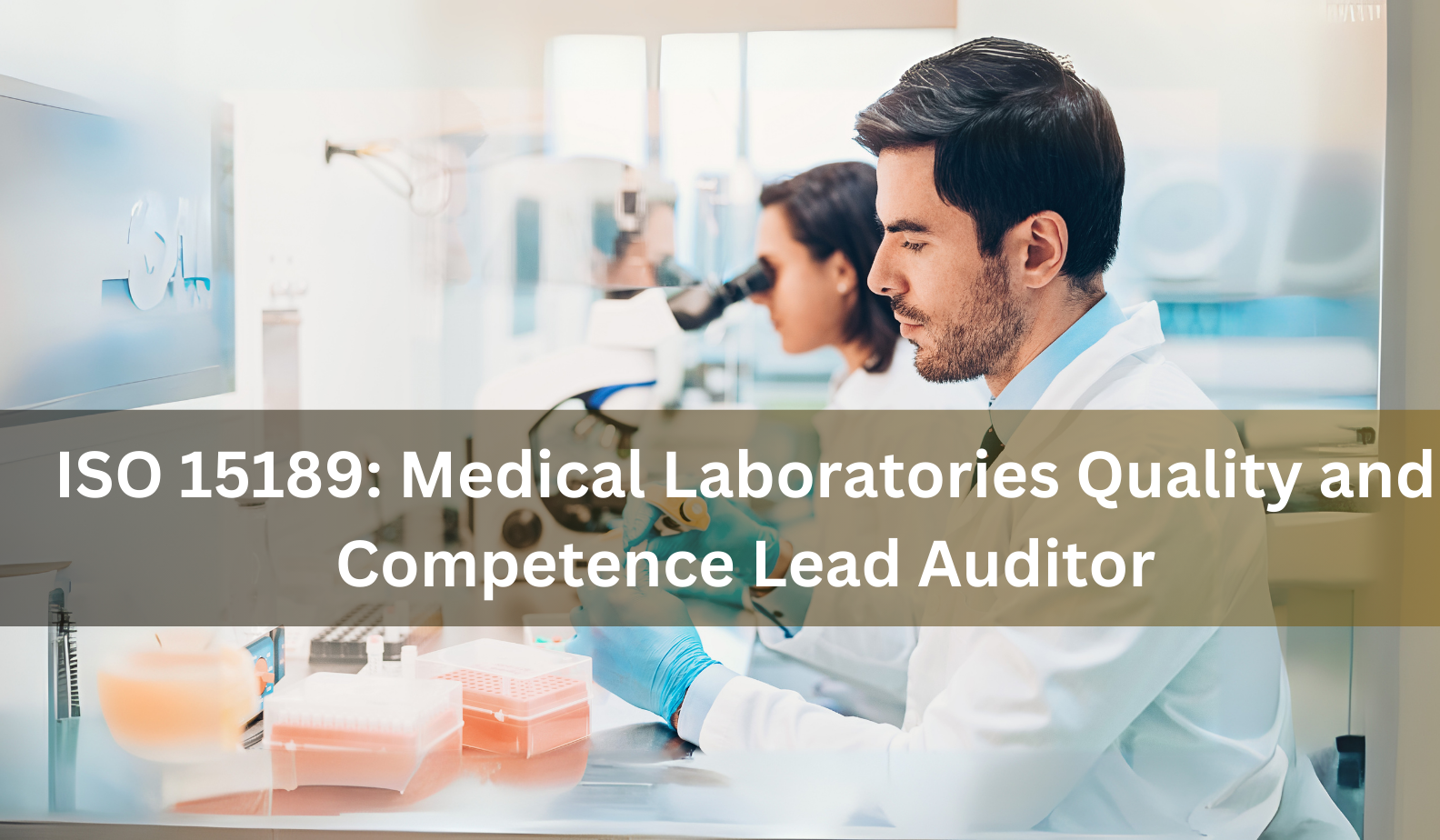
ISO 15189: Medical Laboratories Quality and Competence Lead Auditor
- Global Recognition: Attain a Lead Auditor certification aligned with ISO 15189, enhancing credibility and career prospects.
- Industry Relevance: Gain expertise in medical laboratory standards critical for patient safety and quality healthcare services.
- Practical Skills: Learn to plan, execute, and lead audits tailored to medical laboratory settings.
- Enhanced Compliance: Support laboratories in achieving accreditation and maintaining compliance with international standards.
- Career Advancement: Open doors to leadership roles in quality management, healthcare auditing, and laboratory consultancy.
- Understand the principles and requirements of ISO 15189 for medical laboratories.
- Evaluate the competence and operational efficiency of laboratory processes.
- Plan and conduct audits for medical laboratories based on ISO 15189.
- Identify non-conformities and recommend corrective actions for continual improvement.
- Ensure laboratories meet quality and competence standards critical for accreditation.
- Lead audit teams effectively and communicate findings with stakeholders.
- Introduction to Medical Laboratory Standards
- Importance of ISO 15189 in ensuring patient safety and reliable results.
- Key drivers of quality and competence in healthcare laboratories.
- Core Requirements of ISO 15189
- Quality management principles: Leadership, documentation, and continual improvement.
- Technical requirements: Equipment calibration, staff training, and test validation.
- Audit Methodology
- Planning, conducting, and reporting audits in line with ISO 15189.
- Techniques for effective evidence collection and process evaluation.
- Assessing Laboratory Competence
- Evaluating personnel qualifications, training, and adherence to protocols.
- Ensuring the validity of test results and quality control measures.
- Audit Reporting and Improvement Actions
- Preparing actionable and comprehensive audit reports.
- Defining corrective actions and verifying their effectiveness.
- Achieving and Maintaining Accreditation
- Steps for obtaining ISO 15189 accreditation.
- Strategies for continuous compliance and quality improvement.
- Advanced Topics in Medical Laboratory Auditing
- Risk management and patient-centered care.
- Emerging trends in laboratory quality and technology.
- Advanced Roles in Healthcare Auditing
- Medical Laboratory Auditor: Specialize in auditing healthcare and laboratory facilities.
- Quality Assurance Manager: Oversee quality systems in medical laboratories.
- Consultancy and Advisory Services
- Provide consultancy for ISO 15189 implementation and accreditation.
- Assist laboratories in improving quality, competence, and patient outcomes.
- Leadership Roles in Laboratory Management
- Laboratory Director: Lead operations and quality management systems.
- Healthcare Quality Manager: Drive excellence in healthcare service delivery.
- Broaden Expertise with Related Certifications
- ISO 9001 Lead Auditor: Expand skills in general quality management systems.
- ISO 17025 Lead Auditor: Specialize in laboratory accreditation for testing and calibration.
- Expert Trainers: Learn from seasoned professionals with extensive experience in medical laboratory quality management.
- Comprehensive Learning Materials: Access up-to-date course content, templates, and case studies.
- Global Certification: Earn a credential recognized worldwide, enhancing career prospects.
- Interactive Training: Participate in practical exercises, group discussions, and real-world scenarios.
- Post-Course Support: Receive guidance on applying knowledge in professional settings.
Study Units
- Introduction to ISO 15189 and Quality Management Systems
- Overview of ISO 15189 standards and their importance in medical laboratories.
- Key principles of quality management and competence in healthcare settings.
- Audit Fundamentals for Medical Laboratories
- Understanding the audit process and methodology specific to ISO 15189.
- Ethical responsibilities and competencies of a Lead Auditor.
- ISO 15189 Requirements
- Detailed exploration of quality management and technical requirements.
- Focus on patient-centered care, safety, and accurate laboratory results.
- Audit Planning and Preparation
- Developing audit objectives, scope, and criteria for medical laboratories.
- Creating risk-based audit plans and gathering relevant documentation.
- Conducting the Audit
- Techniques for evaluating laboratory processes, equipment, and personnel competence.
- Identifying areas for improvement in laboratory workflows.
- Audit Findings and Reporting
- Preparing detailed audit reports and communicating findings effectively.
- Defining corrective and preventive actions for non-conformities.
- Accreditation and Compliance
- Understanding the process of ISO 15189 accreditation.
- Tools for maintaining compliance and supporting continuous improvement.
- Case Studies and Practical Exercises
- Role-playing scenarios and case studies of ISO 15189 audits.
- Hands-on exercises for identifying gaps and recommending solutions.
Upon successful completion, participants will demonstrate the ability to:
Interpret ISO 15189 Requirements – Understand both management and technical clauses governing medical laboratory operations.
Evaluate Laboratory Competence – Assess staff qualifications, test validation, equipment calibration, and traceability.
Plan and Lead Audits – Develop risk-based audit plans and lead multidisciplinary audit teams.
Analyze Quality and Technical Processes – Evaluate testing accuracy, sample management, and reporting systems.
Identify Non-Conformities – Recognize deviations and develop effective corrective and preventive actions (CAPA).
Ensure Regulatory Compliance – Align laboratory systems with healthcare and accreditation authority requirements.
Report and Communicate Effectively – Prepare detailed audit reports, communicate findings to leadership, and recommend improvements.
Drive Continuous Improvement – Promote an ongoing culture of excellence, accuracy, and patient-focused care.
This course is tailored for professionals involved in medical laboratory operations, accreditation, and quality control, including:
Medical Laboratory Managers and Supervisors overseeing laboratory compliance and process improvement.
Quality Assurance and Quality Control Managers implementing ISO-based systems in healthcare.
Internal and External Auditors conducting laboratory audits for accreditation or certification.
Healthcare and Diagnostic Professionals seeking to ensure laboratory quality and patient safety.
Regulatory Compliance and Accreditation Officers responsible for maintaining conformance with national or international standards.
Consultants and Technical Advisors providing ISO 15189 implementation and audit readiness services.
Pathologists and Biomedical Scientists interested in understanding audit expectations for clinical laboratory excellence.
Our assessment process is designed to ensure every learner achieves the required level of knowledge, skills, and understanding outlined in each course unit.
Purpose of Assessment
Assessment helps measure how well a learner has met the learning outcomes. It ensures consistency, quality, and fairness across all learners.
What Learners Need to Do
Learners must provide clear evidence that shows they have met all the learning outcomes and assessment criteria for each unit. This evidence can take different forms depending on the course and type of learning.
Types of Acceptable Evidence
Assignments, reports, or projects
Worksheets or written tasks
Portfolios of practical work
Answers to oral or written questions
Test or exam papers
Understanding the Structure
Learning outcomes explain what learners should know, understand, or be able to do.
Assessment criteria set the standard learners must meet to achieve each learning outcome.
Assessment Guidelines
All assessment must be authentic, current, and relevant to the unit.
Evidence must match each assessment criterion clearly.
Plagiarism or copied work is not accepted.
All learners must complete assessments within the given timelines.
Where applicable, assessments may be reviewed or verified by internal or external quality assurers.
Full learning outcomes and assessment criteria for each qualification are available from page 8 of the course handbook.
Top Courses
No results found.
Related Courses
Let's Get in touch
Deleting Course Review
Course Access
This course is password protected. To access it please enter your password below:


